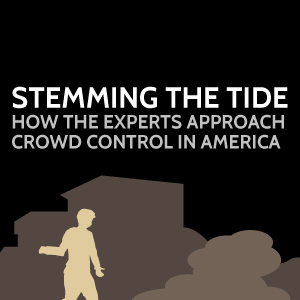
Stemming the Tide: How the Experts Approach Crowd Control in America
Early riots in U.S. Colonial history
• June 20, 1783 Philadelphia. Anti-government protest by 400 soldiers of the Continental Army.
• Aug. 29, 1786 – Massachusetts. Shay’s Rebellion. New government tried to collect debts. 4 killed, 20 wounded.
• 1794. Pennsylvania. Whiskey Rebellion. Fighting excise tax on whiskey. 500 people attacked a tax collector’s office.
The 5 Most Destructive U.S. Riots
1863, New York City. Protesting the draft
• 120-2000: best estimate of people killed.
• $1-5 million: damages
July 13, 1977. New York City blackout: arson and looting
• Over $300 million: damages.
• Over 1,600 stores damaged,
• Over 1,000 fires were reported and
• 3,776 people were arrested: the largest mass arrest in city history.
April 4, 1968. America. Reaction to Martin Luther King assassination
• Riots in more than 100 major American cities.
• Chicago: 28 blocks inundated with looting and arson
• 10,000 police officers mobilized in Chicago.
• More than $10 million: damages in Chicago.
Aug. 11, 1965. Watts, in Los Angeles. Reaction to police brutality
• 6 days: of rioting
• 34: number of rioters killed.
• $40 million: damages.
April 29, 1992. Los Angeles. Reaction to Rodney King verdict
• Widespread arson, looting, assaults in L.A.
• 53: people killed.
• Thousands: injured.
• 1,000: number of buildings destroyed by fire.
• $1 billion: damages.
Mobs/Crowds can be:
• Casual: individuals gather with no common purpose
• Cohesive: individuals assemble for a common purpose like a sports event or concert
• Expressive: gather for a unified purpose such as a demonstration or protest.
• Aggressive. Strong unity of purpose and group identity. Can be provoked into lawless behavior
Crowds can morph into mobs with the right catalyst(s).
Type of mobs:
• Aggressive: engage in violent and lawless behavior.
• Expressive: view violence as a legitimate tool of rebellion, resistance, or protest.
• Acquisitive: Looters exploiting chaos or confusion
• Seeking escape. Persons fleeing imminent danger. These are extremely difficult to control since they are sustained by fear.
Guiding Principles for Major-Event Security
• Plan for worst-case scenarios: extraordinary crimes, violence by protestors, a possible terrorist attack, natural disasters—but also be prepared to deal with ordinary crimes and incidents (pickpockets, thefts from autos, disorderly conduct, etc.)
• Weigh the security measures (for example, street closures, searches, highly visible tactical units) against the desire to produce enjoyable, well attended, and profitable events.
• Respect freedom of speech and assembly.
• Anticipate spur of-the-moment gatherings
• Make sure DHS state homeland security advisers, are informed in advance for possible federal support
• Involve citizens and the business community in planning efforts
• Consider building event security training.
If worse comes to worst: Riot control tactics on the battle-line:
Signs of violence that signal economic riots and civil unrest inside U.S. are escalating:
• Flash mob attacks everywhere
• 48: percentage of U.S. people who believe there is economic unfairness
• Consumer confidence low
• Unemployment still high
• Sales of safes and vaults soaring
The future is now: Online riots….?
• The hacker group DERP has taken down multiple online gaming servers for:
• League of Legends
• Dota 2
• Battle.net
• EA.com
• Club Penguin
Sources:
http://thesportjournal.org/article/crowd-management-past-and-contemporary-issues/
http://www.policechiefmagazine.org/magazine/index.cfm?fuseaction=display_arch&article_id=1347&issue_id=122007
http://www.cnbc.com/id/41372364/page/1
http://www.infowars.com/10-signs-that-us-riots-and-unrest-are-now-more-likely-than-ever/
http://people.howstuffworks.com/riot-control1.htm
http://www.ign.com/articles/2013/12/31/hacker-group-derp-takes-down-multiple-online-gaming-servers
